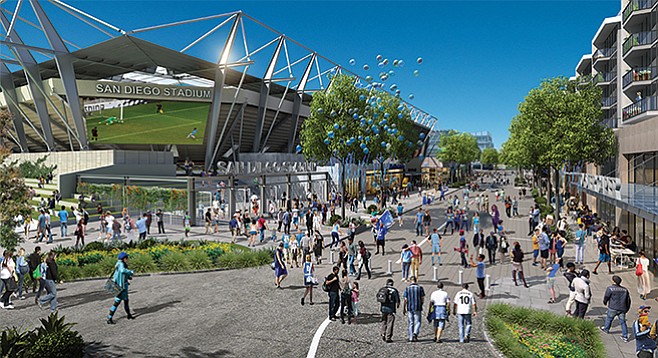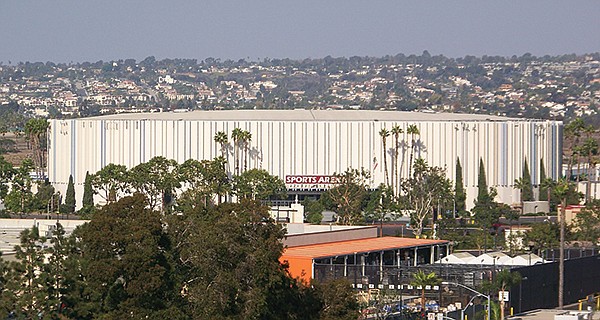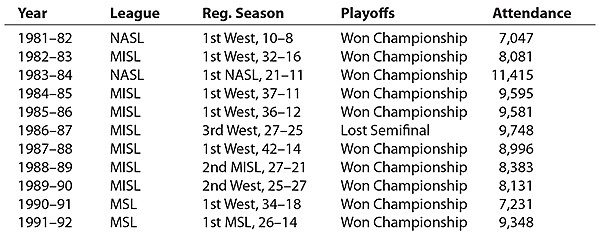 Facebook
Facebook
 X
X
 Instagram
Instagram
 TikTok
TikTok
 Youtube
Youtube

Fútbol? Football? Everybody chatters about the so-called plan for a soccer/football stadium and surrounding development in Mission Valley. Will taxpayers get fleeced? Why does San Diego State seem so queasy? Should we preserve Qualcomm Stadium lest the Chargers bomb out in Los Angeles and limp back to San Diego? Will the Raiders come to San Diego?

Another question is critical: is Major League Soccer — the league in which a San Diego team would supposedly play — reputable and financially solid?
The answer: San Diego, watch out.
Not surprisingly, as in the past, a Union-Tribune columnist is labeling anyone who attempts to do homework on the topic an “obstructionist.” This suggests that mainstream media propaganda will be deployed to drown out tough financial analysis.
Last August, when Major League Soccer revealed that at some time in the future, the expansion fee for the league would be $200 million, a writer for SBNation.com said that such an expense could actually pencil out. It’s a medium-term “sit and hold” strategy, said the scribe. “Business owners buy a sports franchise for the medium or long-term: they hope annual revenue covers costs like player salaries, they try to squeeze a publicly financed stadium out of local politicos, they bank on always-increasing TV revenue, and then they sell the franchise at a handsome profit after a decade or two.” In short, they probably need a fat taxpayer subsidy to make the caper work. Remember John Moores? He got huge subsidies for a ballpark and surrounding land, made a bundle, and fled back to Texas.
Discussing pro soccer stadiums, a writer for Sports Illustrated put forward this warning: “Study after study has revealed stadium subsidies to be a remarkably inefficient stimulus [to the local economy], providing a major boost to franchise values but little net benefit to the region that pays. Yet the racket remains alive.”
Major League Soccer — indeed, professional soccer itself — has much in common with a racket. It’s not an association of independently owned teams. Someone sponsoring a team now pays $150 million to the league itself, although the donor is erroneously called the team owner. The league has said an investor, all told, will put “north of $300 million” into a team — $150 million to the league and more than $150 million into a stadium. A stadium, even one seating only 30,000 people, is going to cost far, far more than $150 million — unless, of course, taxpayers pick up a fat percentage of the tab.

In mid-2015, the league admitted it is losing money but wouldn’t say how much. Then, the league said average attendance was 21,109 per game. That engendered guffaws. The league’s “attendance figures are even more fictitious than we realized,” wrote Neil deMause of FieldofSchemes.com late last year. Some say that through the years, 30 percent of tickets have been giveaways. The league’s marketing honcho now says that freebies are down to 9 percent of attendance, but some cock an eyebrow at that. “If you really think you’re going to have 20,000 fans a night show up and spend money, you should be mentally replacing a large chunk of that number with ghosts,” said deMause, warning cities of the league’s economic-stimulus claims.
The league now has 22 teams and expects to have 26 by 2020. A second Los Angeles team and one in Miami are all but certain additions. Other cities expressing interest are Charlotte, Cincinnati, Detroit, Nashville, Raleigh/Durham, Sacramento, St. Louis, Tampa/St. Petersburg, and, of course, San Diego. Some fat moneybags, such as Tom Gores, former owner of the Union-Tribune, are said to be salivating over the prospects of getting a team. Financially fragile St. Louis, despite being cuckolded twice by the National Football League, is preparing to give a total of $127 million to the hockey and soccer teams, although, mercifully, citizens will vote on the latter next month.
Will soccer succeed in San Diego? Between 1981 and 1992, San Diego was home to one of the most remarkable teams in sports history. The San Diego Sockers, playing mainly indoors, won ten championships and lost out in the semifinals the other season. They played home games in the then-named San Diego Sports Arena, which seated about 14,000. In only one of those years did average attendance go over 10,000. In the other years, it was 7000 to 9500.
The average annual Major League Soccer salary is $317,000, but the median is $117,000. That’s less than the players on major European teams make in a week ($130,600). The average yearly salary for European players is $6.8 million. Major League Soccer has a salary cap of $3.84 million per team. Thus, to make it possible to recruit expensive talent from overseas, the league created the Designated Player Rule, which allows teams to pay a limited number of stars high salaries that don’t count against the salary cap. Still, I went over the league player salaries, as provided by the Major League Soccer Players Union. Very seldom did I see a salary of more than $1 million.
One lure to potential investors is television. But total league yearly TV revenues in the U.S. are $40 million. By contrast, every National Football League team rakes in more than $220 million a year from TV.
Another problem is the worldwide corruption in soccer itself. Switzerland-based Fédération Internationale de Football (known as FIFA) regulates and markets soccer and is in charge of major international tournaments. In May of 2015, the United States charged individuals in the organization with racketeering, wire fraud, money laundering, and other sins. Bribery appears to be a way of life in soccer. Since 2015, there have been internal investigations of the former president of the organization and two lieutenants.
Major League Soccer is tied to FIFA, and that tarnishes the American league.
In 1999, the Major League Soccer entrance fee was $5 million. In 2009, the Seattle Sounders paid $30 million. Then came the big leap to the current $150 million, despite the money being lost.
In 2015, Stefan Szymanski, professor of sports management at the University of Michigan, asked why nabobs pay such huge and billowing sums to enter a losing business. He asked questions about bloated attendance and measly broadcast revenue. He snorted that the league sounds “like a pyramid scheme.” He asked one of his critics if he might be an admirer of Bernie Madoff. And he wondered if the league might collapse.


Fútbol? Football? Everybody chatters about the so-called plan for a soccer/football stadium and surrounding development in Mission Valley. Will taxpayers get fleeced? Why does San Diego State seem so queasy? Should we preserve Qualcomm Stadium lest the Chargers bomb out in Los Angeles and limp back to San Diego? Will the Raiders come to San Diego?

Another question is critical: is Major League Soccer — the league in which a San Diego team would supposedly play — reputable and financially solid?
The answer: San Diego, watch out.
Not surprisingly, as in the past, a Union-Tribune columnist is labeling anyone who attempts to do homework on the topic an “obstructionist.” This suggests that mainstream media propaganda will be deployed to drown out tough financial analysis.
Last August, when Major League Soccer revealed that at some time in the future, the expansion fee for the league would be $200 million, a writer for SBNation.com said that such an expense could actually pencil out. It’s a medium-term “sit and hold” strategy, said the scribe. “Business owners buy a sports franchise for the medium or long-term: they hope annual revenue covers costs like player salaries, they try to squeeze a publicly financed stadium out of local politicos, they bank on always-increasing TV revenue, and then they sell the franchise at a handsome profit after a decade or two.” In short, they probably need a fat taxpayer subsidy to make the caper work. Remember John Moores? He got huge subsidies for a ballpark and surrounding land, made a bundle, and fled back to Texas.
Discussing pro soccer stadiums, a writer for Sports Illustrated put forward this warning: “Study after study has revealed stadium subsidies to be a remarkably inefficient stimulus [to the local economy], providing a major boost to franchise values but little net benefit to the region that pays. Yet the racket remains alive.”
Major League Soccer — indeed, professional soccer itself — has much in common with a racket. It’s not an association of independently owned teams. Someone sponsoring a team now pays $150 million to the league itself, although the donor is erroneously called the team owner. The league has said an investor, all told, will put “north of $300 million” into a team — $150 million to the league and more than $150 million into a stadium. A stadium, even one seating only 30,000 people, is going to cost far, far more than $150 million — unless, of course, taxpayers pick up a fat percentage of the tab.

In mid-2015, the league admitted it is losing money but wouldn’t say how much. Then, the league said average attendance was 21,109 per game. That engendered guffaws. The league’s “attendance figures are even more fictitious than we realized,” wrote Neil deMause of FieldofSchemes.com late last year. Some say that through the years, 30 percent of tickets have been giveaways. The league’s marketing honcho now says that freebies are down to 9 percent of attendance, but some cock an eyebrow at that. “If you really think you’re going to have 20,000 fans a night show up and spend money, you should be mentally replacing a large chunk of that number with ghosts,” said deMause, warning cities of the league’s economic-stimulus claims.
The league now has 22 teams and expects to have 26 by 2020. A second Los Angeles team and one in Miami are all but certain additions. Other cities expressing interest are Charlotte, Cincinnati, Detroit, Nashville, Raleigh/Durham, Sacramento, St. Louis, Tampa/St. Petersburg, and, of course, San Diego. Some fat moneybags, such as Tom Gores, former owner of the Union-Tribune, are said to be salivating over the prospects of getting a team. Financially fragile St. Louis, despite being cuckolded twice by the National Football League, is preparing to give a total of $127 million to the hockey and soccer teams, although, mercifully, citizens will vote on the latter next month.
Will soccer succeed in San Diego? Between 1981 and 1992, San Diego was home to one of the most remarkable teams in sports history. The San Diego Sockers, playing mainly indoors, won ten championships and lost out in the semifinals the other season. They played home games in the then-named San Diego Sports Arena, which seated about 14,000. In only one of those years did average attendance go over 10,000. In the other years, it was 7000 to 9500.
The average annual Major League Soccer salary is $317,000, but the median is $117,000. That’s less than the players on major European teams make in a week ($130,600). The average yearly salary for European players is $6.8 million. Major League Soccer has a salary cap of $3.84 million per team. Thus, to make it possible to recruit expensive talent from overseas, the league created the Designated Player Rule, which allows teams to pay a limited number of stars high salaries that don’t count against the salary cap. Still, I went over the league player salaries, as provided by the Major League Soccer Players Union. Very seldom did I see a salary of more than $1 million.
One lure to potential investors is television. But total league yearly TV revenues in the U.S. are $40 million. By contrast, every National Football League team rakes in more than $220 million a year from TV.
Another problem is the worldwide corruption in soccer itself. Switzerland-based Fédération Internationale de Football (known as FIFA) regulates and markets soccer and is in charge of major international tournaments. In May of 2015, the United States charged individuals in the organization with racketeering, wire fraud, money laundering, and other sins. Bribery appears to be a way of life in soccer. Since 2015, there have been internal investigations of the former president of the organization and two lieutenants.
Major League Soccer is tied to FIFA, and that tarnishes the American league.
In 1999, the Major League Soccer entrance fee was $5 million. In 2009, the Seattle Sounders paid $30 million. Then came the big leap to the current $150 million, despite the money being lost.
In 2015, Stefan Szymanski, professor of sports management at the University of Michigan, asked why nabobs pay such huge and billowing sums to enter a losing business. He asked questions about bloated attendance and measly broadcast revenue. He snorted that the league sounds “like a pyramid scheme.” He asked one of his critics if he might be an admirer of Bernie Madoff. And he wondered if the league might collapse.
Comments